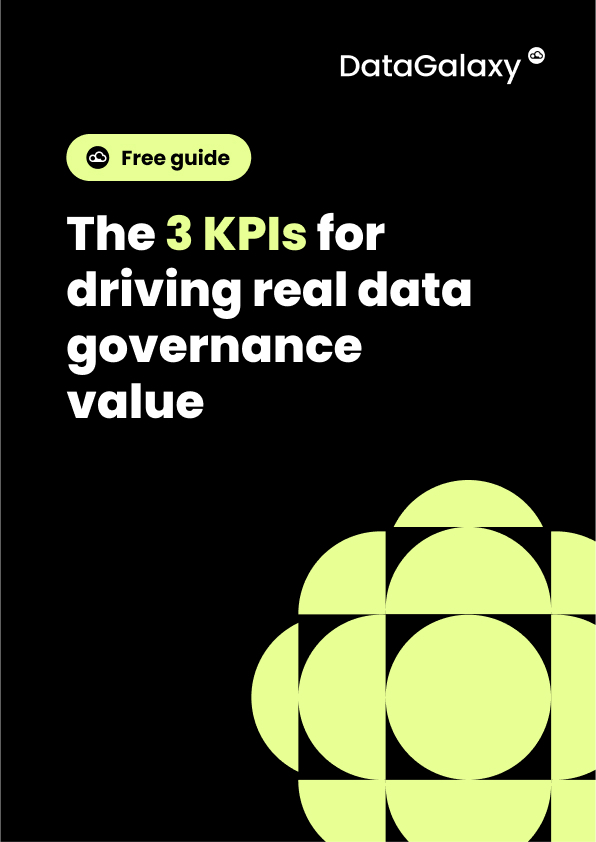
Value governance: The New Frontier for maximizing & communicating data-driven business value
To make a difference, businesses must go a step further. They must govern the value derived from data.
This concept, known as value governance, is emerging as a pivotal framework for organizations seeking to align data, analytics, and AI investments directly with business outcomes.
In this article, we’ll explain what value governance really means, how it differs from traditional data governance, the key principles behind it, and why it’s becoming a must-have for organizations looking to get the most from their data investments.
TL;DR summary
It’s one thing to manage your data; it’s another to transform it into actionable insights and measurable business value. As organizations face accelerating business and technology disruption, the pressure on data leaders to demonstrate impact—quickly and in business terms—has never been greater.
In this article, we explore what value governance means, how it connects to the broader challenge of value optimization, and the principles and practices organizations need to adopt to ensure data becomes a consistent driver of impact, innovation, and competitive advantage.
What is value governance?
Value governance is the discipline of ensuring that data, analytics, and AI initiatives are continuously aligned with organizational goals to deliver measurable business value.
It extends beyond ensuring data is secure, accurate, and compliant to maximize the impact and ROI of data assets and projects.
At its core, value governance provides a framework for:
- Prioritizing data initiatives based on business outcomes
- Tracking the value creation from data and AI usage
- Engaging stakeholders across business and IT to drive alignment
- Ensuring accountability for results tied to data-driven decision-making
Rather than viewing governance as a set of constraints or rules, value governance treats it as an enabler and a strategic mechanism for turning data into a continuous source of innovation, efficiency, and competitive advantage.
Value governance vs. data governance
While data governance and value governance are closely related, they are not interchangeable. Here’s a closer look at how they differ:
| Aspect | Data governance | Value governance |
|---|---|---|
| Focus | Metadata, data lineage, and access policies | Business value derived from data |
| Scope | Accuracy, completeness, and regulatory compliance | Strategic alignment, ROI tracking, and outcome measurement |
| Ownership | Typically IT-led | Shared between business and IT |
| Success metrics | Accuracy, completeness, regulatory compliance | Revenue growth, cost savings, operational efficiency, and innovation impact |
Think of value governance as the “Why” behind data governance.
Data governance ensures data is managed effectively, but value governance ensures that managing data results in something meaningful: Business impact.
The importance of balancing value & data governance
While value governance focuses on aligning data efforts with business outcomes, it doesn’t replace the need for strong data governance.
Data governance ensures that your data is accurate, secure, and well-managed, laying the foundation for trust and compliance. However, without value governance, even the most pristine data can fall short of driving real impact.
Designing data & AI products that deliver business value
To truly derive value from AI, it’s not enough to just have the technology.
- Clear strategy
- Reasonable rules for managing data
- Focus on building useful data products

Together, they form a complete picture: Data governance keeps the engine running smoothly, while value governance ensures it’s driving in the right direction.
In short, organizations need both to turn data into meaningful, measurable business results.
Why value governance is a business imperative
Data is often considered one of the most valuable assets in the digital age, yet turning it into meaningful business outcomes remains difficult. Most data and analytics leaders struggle to articulate the value they create in terms that resonate with executives—revenue, cost savings, risk reduction, customer experience, or strategic advantage.
To bridge this gap, organizations must move beyond data management and toward systematically governing the value produced by data initiatives.
Value governance addresses this need by:
- Aligning data, analytics, and AI programs with business priorities
- Ensuring executive sponsorship and cross-functional collaboration
- Demonstrating measurable outcomes using transparent, outcome-driven metrics
- Enabling organizations to adjust portfolios and investments as priorities evolve
In essence, value governance connects the why of data strategy with the how of data execution—ensuring data-driven change is intentional, accountable, and tied directly to mission-critical outcomes.
Building the foundation: Key principles of value governance
Implementing value governance requires a shift in both mindset and practice.
The core pillars that define an effective value governance strategy include:
1. Business-driven prioritization
Every data initiative should begin with a clear understanding of the business need it serves.
Whether the goal is to reduce customer churn, improve supply chain efficiency, or launch a new product, value governance starts with business objectives, not data.
This means engaging business stakeholders early to identify priorities and ensure data efforts are tightly linked to what matters most.
2. Transparent value metrics
To govern value, you need to measure it. That means defining and tracking value metrics tied to data usage, such as revenue impact, time saved, costs avoided, or improved customer satisfaction.
Value governance embeds these metrics into every data product or initiative’s lifecycle, ensuring a clear path from effort to outcome.
3. Cross-functional ownership
Proper value governance is a shared responsibility.
IT, data teams, business units, and executive leadership play a role, and this requires a culture of collaboration, where data consumers and data stewards work together to drive insights and impact.
Platforms and practices should encourage shared accountability, with clear roles and responsibilities.
4. Agile, iterative delivery
Value governance favors agile approaches instead of long, monolithic data projects.
Smaller, iterative deployments enable teams to learn quickly, adjust course, and deliver value faster. Value governance must support, speed up, and help teams balance projects with responsiveness.
5. Feedback & continuous improvement
Value governance is not something that can be completed overnight.
As business conditions evolve, so do data strategies. A mature value governance framework includes mechanisms for continuous feedback and learning, ensuring organizations can adapt, improve, and scale what works.
CDO Masterclass: Upgrade your data leadership in just 3 days
Join DataGalaxy’s CDO Masterclass to gain actionable strategies, learn from global leaders like Airbus and LVMH, and earn an industry-recognized certification.
Save your seat!How value governance drives business value
Done right, value governance becomes the bridge between data and impact. Here’s how it delivers results across the enterprise:
Increased ROI on data & AI initiatives
By tying every initiative to a business outcome and tracking results, organizations can eliminate wasteful data projects and focus resources on what truly matters
Faster time-to-value
With clear priorities and agile delivery models, value governance reduces time spent on planning and red tape, accelerating the delivery of actionable insights
Greater stakeholder trust
Transparency around value creation builds trust between business and data teams, fostering stronger collaboration and a shared sense of ownership
Stronger strategic alignment
When data efforts are governed through the lens of business value, aligning initiatives with company strategy becomes easier, ensuring data is not just technically sound but strategically relevant
Resilience & scalability
Value governance equips organizations to adapt to change, whether market shifts, regulatory updates, or emerging technologies, by focusing on outcomes and iterating based on real-world feedback
Why assigning value to data matters
Value governance isn’t just a measurement exercise—it is a mechanism for shaping smarter investments. When organizations clearly understand the financial and strategic impact of their data initiatives, they can justify:
- Portfolio optimization decisions
- The allocation of scarce resources
- Long-term investments in data and AI capabilities
Beyond near-term returns, data and analytics programs influence critical leading indicators, including:
- Innovation potential
- Organizational agility
- Brand strength
- Employee and customer retention
- Enterprise know-how
- Achievement of mission-driven objectives
Recognizing these intangible yet powerful drivers is essential for capturing the true value of data.
Taking action: How organizations can maximize data value
To operationalize value governance and unlock the full potential of data, data leaders should:
Build value stories
Show clear links between initiatives and mission-critical priorities, supported by transparent metrics.
Prioritize investments based on value
Consistently score options based on financial and non-financial benefits and risks.
Identify opportunities to improve decisions
Use value stream analysis and design thinking to target high-impact areas across the enterprise.
Measure, monitor, and adjust
Use clear KPIs to evaluate portfolio performance and pivot where necessary.
This approach ensures organizations deliver the outcomes they expect—and communicate them effectively across the business.
DataGalaxy: A modern platform for value governance
As the need for value governance grows, data professionals require tools that support both technical governance and business-centric, collaborative, and agile governance.
DataGalaxy is a Data & AI Governance Platform purpose-built to bridge the gap between technical data management and business value realization.

The 3 KPIs for driving real data governance value
KPIs only matter if you track them.
Move from governance in theory to governance that delivers.
Download the free guideDataGalaxy connects strategy, technology, and teams to turn data into real business value. By structuring use cases, managing portfolios, and governing assets, we help organizations focus on what matters, move faster, and confidently deliver impact.
We empower data teams, business stakeholders, and AI practitioners to:
- Map business objectives to data assets, ensuring alignment and traceability
- Monitor value delivery with embedded KPIs and impact tracking
- Maintain data quality and compliance without sacrificing speed or agility
- Collaborate across silos using intuitive interfaces and shared documentation
- Accelerate data product development through reusable assets and workflows
By integrating value governance principles into every layer of its platform, DataGalaxy helps organizations move from passive data governance to proactive value creation by transforming data governance from a checkbox into a strategic advantage.
While traditional data governance ensures your data is well-managed, value governance ensures it’s worth managing—that it delivers ROI, innovation, and impact. To implement this effectively, modern teams need modern tools.
With DataGalaxy, data-driven professionals gain the visibility, collaboration, and agility they need to put value at the heart of every data initiative.
The future of governance is not just about managing data; it’s about maximizing its value.
That future starts with value governance.
FAQ
- What is data governance?
-
Data governance ensures data is accurate, secure, and responsibly used by defining rules, roles, and processes. It includes setting policies, assigning ownership, and establishing standards for managing data throughout its lifecycle.
- How do I implement data governance?
-
To implement data governance, start by defining clear goals and scope. Assign roles like data owners and stewards, and create policies for access, privacy, and quality. Use tools like data catalogs and metadata platforms to automate enforcement, track lineage, and ensure visibility and control across your data assets.
- What is reference data?
-
Reference data categorizes other data—like country or currency codes—and provides a stable framework for consistency across systems. Proper management supports data quality, compliance, and operational efficiency by ensuring accurate, reliable reporting and analysis.
- What is reference data management?
-
Reference data management oversees classifications like country codes or product categories across systems. Since it’s widely shared, consistency and accuracy are essential. Centralized management boosts efficiency, ensures compliance, and supports better decisions through a unified view of key business terms.
- What is information governance?
-
Information governance is a framework for managing and protecting information assets to meet legal, regulatory, and business goals. It aligns policies, roles, and technologies to ensure data is accurate, secure, and ethically used, enhancing compliance and value.
Key points to remember
- Value governance is the emerging framework that ensures data, analytics, and AI initiatives are continuously aligned with business goals and deliver measurable outcomes.
- Traditional data governance manages the quality and compliance of data, while value governance manages the business impact of data. Organizations need both.
- Data leaders face increasing pressure to demonstrate value quickly, requiring stronger alignment between data strategy and mission-critical priorities.
- Value stories and transparent metrics are essential for linking technical initiatives to business outcomes like revenue growth, cost savings, and operational efficiency.
- DataGalaxy provides a modern platform that unifies technical and business governance, helping organizations map strategy to data assets, track value delivery, and scale data product development.

